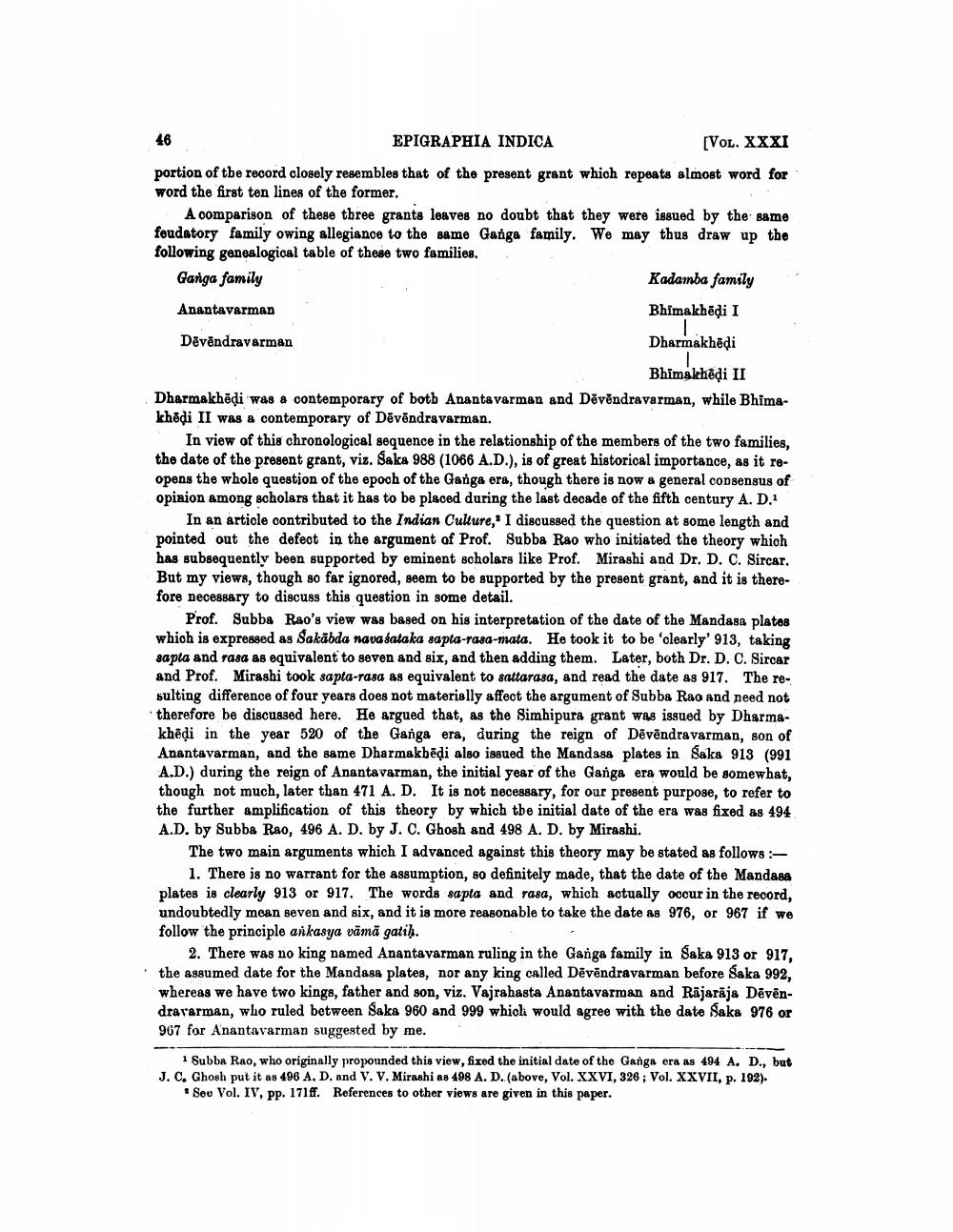________________
EPIGRAPHIA INDICA
[Vol. XXXI portion of the record closely resembles that of the present grant which repeats almost word for word the first ten lines of the former.
A comparison of these three grants leaves no doubt that they were issued by the same feudatory family owing allegiance to the same Ganga family. We may thus draw up the following genealogical table of these two families. Ganga family
Kadamba family Anantavarman
Bhimakhēļi I Dēvēndravarman
Dharmakhēdi
Bhimakhēļi II Dharmakhēdi was a contemporary of both Anantavarman and Dēvēndravarman, while Bhimakhodi II was a contemporary of Dēvēndravarman.
In view of this chronological sequence in the relationship of the members of the two families, the date of the present grant, viz. Saka 988 (1066 A.D.), is of great historical importance, as it reopens the whole question of the epoch of the Ganga era, though there is now a general consensus of opinion among scholars that it has to be placed during the last decade of the fifth century A. D.
In an article contributed to the Indian Culture, ' I discussed the question at some length and pointed out the defect in the argument of Prof. Subba Rao who initiated the theory which has subsequently been supported by eminent scholars like Prof. Mirashi and Dr. D. C. Sircar. But my views, though so far ignored, seem to be supported by the present grant, and it is therefore necessary to discuss this question in some detail.
Prof. Subba Rao's view was based on his interpretation of the date of the Mandasa plates which is expressed as Sakäbda navadataka sapta-rasa-mata. He took it to be clearly' 913, taking sapta and rasa as equivalent to seven and six, and then adding them. Later, both Dr. D. C. Sircar and Prof. Mirashi took sapta-rasa as equivalent to sattarasa, and read the date as 917. The resulting difference of four years does not materially affect the argument of Subba Rao and need not therefore be discussed here. He argued that, as the Simhipura grant was issued by Dharmakhēdi in the year 520 of the Ganga era, during the reign of Dēvēndravarman, son of Anantavarman, and the same Dharmakbēdi also issued the Mandasa plates in Saka 913 (991 A.D.) during the reign of Anantavarman, the initial year of the Ganga era would be somewhat, though not much, later than 471 A. D. It is not necessary, for our present purpose, to refer to the further amplification of this theory by which the initial date of the era was fixed as 494 A.D. by Subba Rao, 496 A. D. by J. C. Ghosh and 498 A. D. by Mirashi.
The two main arguments which I advanced against this theory may be stated as follows -
1. There is no warrant for the assumption, so definitely made, that the date of the Mandasa plates is clearly 913 or 917. The words sapta and rasa, which actually occur in the record, undoubtedly mean seven and six, and it is more reasonable to take the date as 976, or 967 if we follow the principle arkasya vämā gatih.
2. There was no king named Anantavarman ruling in the Ganga family in Saka 913 or 917, • the assumed date for the Mandasa plates, nor any king called Dēvēndravarman before Saka 992,
whereas we have two kings, father and son, viz. Vajrahasta Anantavarman and Rājarāja Dēvēndrararman, who ruled between Saka 960 and 999 whioli would agree with the date Saka 976 or 967 for Anantavarman suggested by me. .
1 Subba Rao, who originally proponnded this view, fixed the initial date of the Ganga era as 494 A. D., but J. C. Ghosh put it as 496 A. D. and V. V. Mirashi as 498 A. D. (above, Vol. XXVI, 326; Vol. XXVII, p. 192).
* Sou Vol. IV, pp. 171ff. References to other views are given in this paper.




